Sometimes you can get stuck in a rut and wonder how to keep your perennial gardens looking beautiful and colorful throughout the entire growing season.
Are you looking for perennials made easy? Like, super duper easy? Then this post is for you! Below I will show you how to design gorgeous ever-blooming flower beds that are full of year-round color.
One of the biggest benefits of growing perennials in your garden instead of annual flowers is that they last for many years. But the downside is that they only bloom for a short time.
People are always sending me photos of their boring all-green (e.g.: no flowers) gardens begging me for advice on how to make the bed look better.
They know something is wrong with it, but they aren’t sure what the problem is, or how to fix it.
They go on to explain that their perennial garden looks amazing for a few weeks every summer, but it’s dull and boring the rest of the year because nothing else ever blooms.
Don’t worry, this is very common for newbie gardeners, and it’s caused by something called flower fixation.
Ok, I just made up that term, but it’s a real problem! Let me explain…
In fact, garden centers usually only sell plants when they’re in full bloom. Once those plants are done blooming, they quickly disappear from the shelves (or go on the clearance rack, where I buy them, muahahaha!).
So, for example, when you walk into a garden center during the summer, the photo below is an example of what you might see…
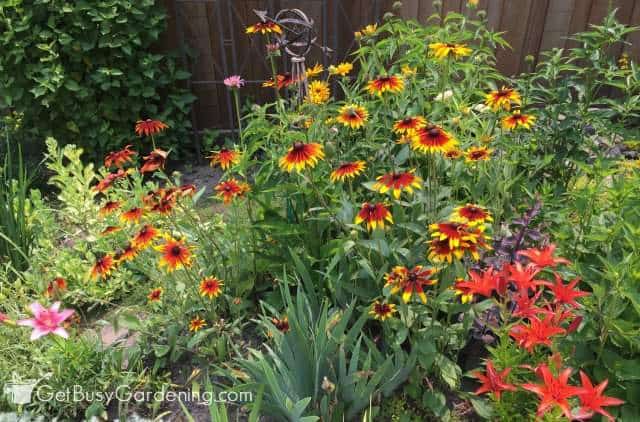
And most people think, “BAM, those flowers look amazing together so I’ll get them for my garden!“.
I mean, how could you go wrong with this amazing color combo, right?!?
Buuuut, since we love to buy plants that are blooming, we tend to forget to think about how long those flowers will last, or what time of the year they will bloom once they’re established in our garden.
And Flower fixation is the number one cause of dull, boring gardens 49 weeks out of the year.
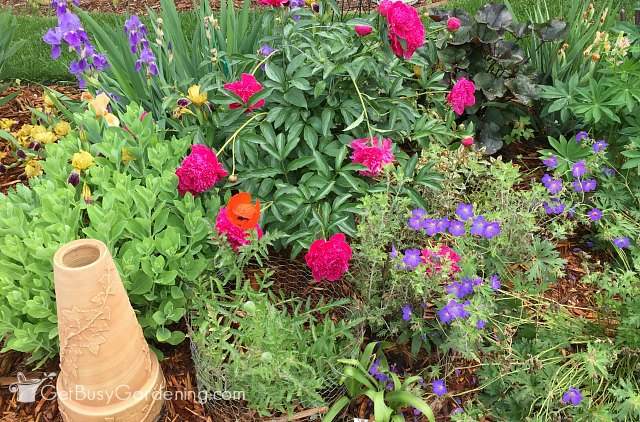
How To Create Gorgeous Perennial Flower Beds
So how can you fix the problem of the boring, mostly green perennial garden? The best thing to do is to first focus on the foliage, and not the flowers.
For example, take a look at this garden area…
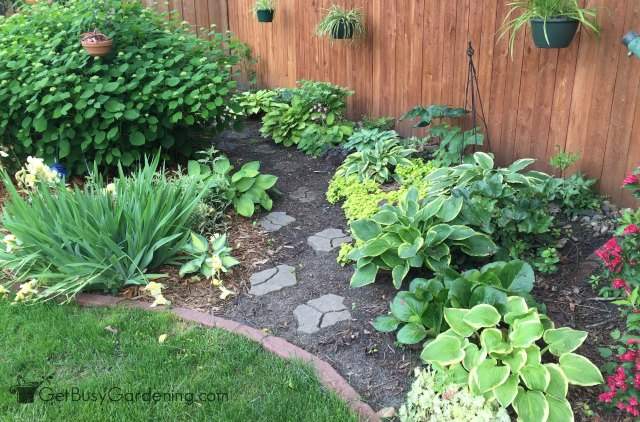
Even though there’s not really anything blooming, this perennial garden is still very colorful and beautiful.
That’s because I mixed in different colors and textures of foliage, rather than everything just being plain, boring green.
There are tons of gorgeous plants out there that add wonderful color to the garden, even when they’re not blooming.
I mean, am I right… BOOM!
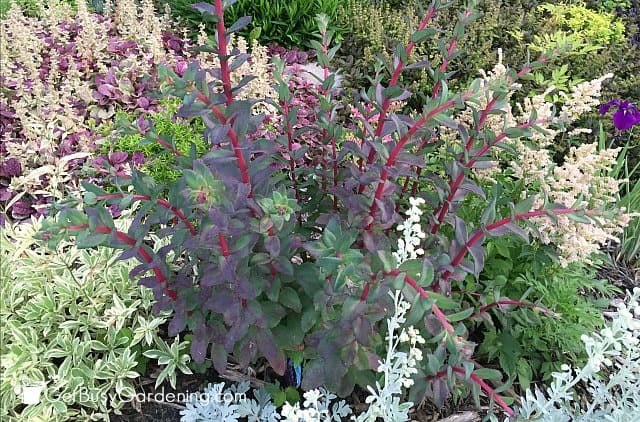
These days, perennial plants come in chartreuse, lime green, dark green, variegated, silver, burgundy, purple, pink, red… well, you can pretty much name your leaf color.
So, the next time you walk into the store, I challenge you to try to ignore the flowers that are all up-in-your-face, and focus only on the foliage.
Think about how you can mix the different foliage colors, textures, shapes, and sizes into your garden.
Try not to put perennials with the same color leaves next to each other, make it your goal to mix in as many contrasting textures and colors as you can.
If you already have a boring, green garden, then adding colorful foliage is the fastest way to rejuvenate the area and add tons of immediate color.
Ok, NOW we can focus on flowers (color AND bloom time!).
Tips For Creating An Ever-Blooming Perennial Garden
Ahhhh flowers, who doesn’t love to see a garden bursting with beautiful flowers?
But be careful, don’t let flower fixation set in again here.
The next thing to focus on is bloom time, NOT how the flowers look in the garden center. Make sure to read every single plant tag before you decide to buy it.
The tag will tell you when you can expect the plant to bloom once it’s established in your garden, and how large it will get (so you don’t have an ugly, overgrown looking bed full of huge plants in a few years).
Sometimes they even give you companion suggestions of what other plants look best when combined with this one.
Ok, wait. Let me show you one more example to really drive this home… take a look at the garden area below.
Only one flower is blooming, but look at that amazing, bold contrast of the orange lily against the backdrop of dark purple perennials and variegated sedum foliage, with the variegated iris spikes in the middle.
Related Post: How To Transplant Plants In Your Garden (5 Steps)
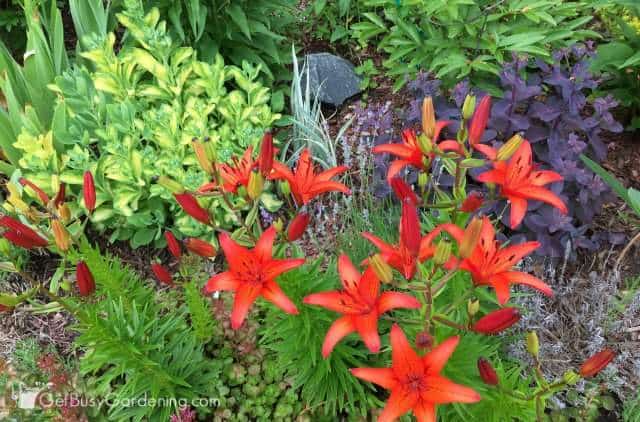
YES! That’s what I’m talking about!
AND, this area looks just as gorgeous in early spring when my irises and peonies are blooming, as it does in the fall once the sedum and lavender flowers steal the show.
See what I mean?
So include perennials that bloom at different times throughout the season. And mix them together as much as you can.
I try not to plant more than 2-3 plants that will flower at the same time next to each other. I like to layer in as much color, height, and texture as I can so my gardens are ever-blooming and gorgeous through the entire growing season.
Ever-blooming color, mixed with all of your contrasting foliage, will create eye-popping perennial flower beds that will be the envy of all your friends and neighbors.
Related Post: 19 Long Blooming Perennials For A More Beautiful Flower Garden
Four Season Perennial Gardens
Flower fixation usually leads to gardens that are gorgeous during the peak of summer… but dull and boring in the spring, fall, and winter.
So, as you select your perennials, think of what your garden will look like during the entire 12 months of the year, and plant accordingly.
Here are some snaps of a few of my perennial gardens through all four seasons of the year.
Moving left to right starting on top, these collages show you what spring, summer, fall, and winter look like in each of these four garden areas.
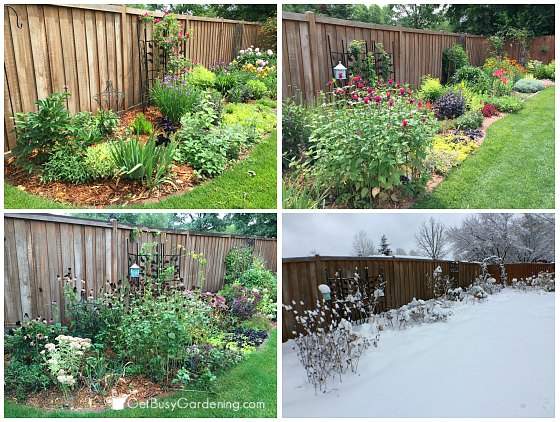

You may never think about what your garden will look like during the winter, but I love to leave a lot of my cleanup chores until spring.
Leaving tall plants in the landscape creates beauty during the winter, and is also great for wildlife (the birds and squirrels are very active in my yard all winter long).
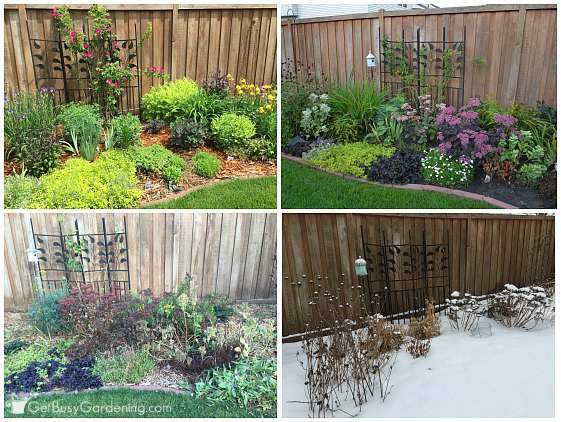
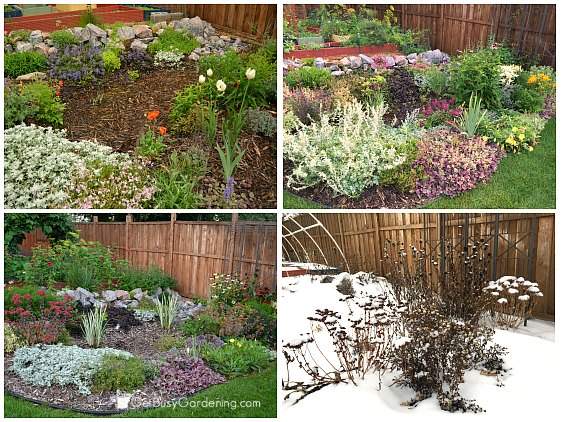
Garden Perennials For Every Season
To help get you started creating your own year-round flower gardens, below I’ve listed some common plants for each season to give you ideas, and get your creative juices flowing.
Early Spring Color
Spring blooming bulbs (like tulips, crocus, and daffodils, for example) will add the first splashes of color in early spring.
Creeping phlox, ajuga, bleeding heart, and colorful foliage plants (like sedums) won’t be far behind.
Related Post: When & How To Plant Your Spring Bulbs
Spring & Early Summer Color
Flowering perennials like peonies, lupine, irises, hardy geraniums, spirea, honeysuckle, weigela, and poppies are great for spring and early summer blooms.
This is also when the foliage colors from hostas, coral bells, sedums, and lungwort really start to pop.
Summer Blooming Perennials
Lilies, coneflowers, hardy hibiscus, rudbeckia, butterfly weed, phlox, liatris, sage, black-eyed Susan… I could go on and on.
But honestly, nobody seems to have trouble finding summer perennial flowers. Be careful adding too much here though, this is the season where flower fixation can really take over.
Fall & Late Blooming Perennials
Sedum (the ones with colorful foliage are especially great for adding year-round color), rue, Russian sage, mums, turtlehead, Japanese anemone, and hardy aster are all beautiful fall flowers.
This is a great time to prune spent blossoms and burnt-out foliage from early perennials to help make the fall bloomers and their foliage really stand out.
Perennials For Winter Interest
Leave tall plants like coneflowers, astilbe, rudbeckia, sedum, and hydrangea in the garden to add winter interest.
Some of the flowers contain seeds that feed the birds too, which adds life and movement to your otherwise boring winter landscape.
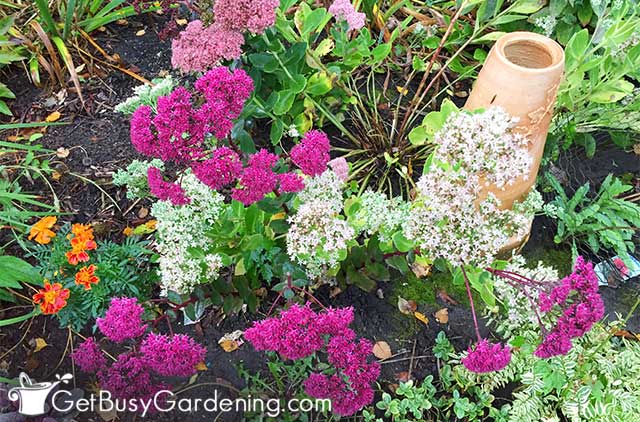
Maintenance Tips For Perennials Made Easy!
Designing eye-popping perennial beds is the first step. But regular maintenance is the key to keeping them looking amazing. Here are a few quick tips to make it easy for you.
Keep The Weeds At Bay
Mulching your beds will help keep the weeds from taking over, and make maintenance much easier.
It also creates a lovely backdrop for perennials to really make the colors pop. I use a natural hardwood mulch that will break down slowly.
To make it a snap to pull out pesky weeds, I highly recommend getting yourself a Hori Hori knife and also a Cobrahead weeder.
I’ve used a lot of gardening tools over the years, and these are two of the best hand weeding tools I’ve ever used.
Feed Your Plants
Perennials need a lot of energy to look their best, so make sure you fertilize them during the spring and summer months.
I like to use a mix of slow-release granules (either one made for flower gardens or an all purpose blend), and organic liquid fertilizers.
Some my favorite liquid options are compost tea and fish emulsion. Learn more about how to fertilize your flower beds here.
Prune Regularly
Pruning not only keeps the garden looking tidy, it also helps plants look their best by growing bushy, full, and compact, and it can encourage more flowers too.
I recommend trimming your perennials at least once a month to remove any spent flowers and burnt out foliage.
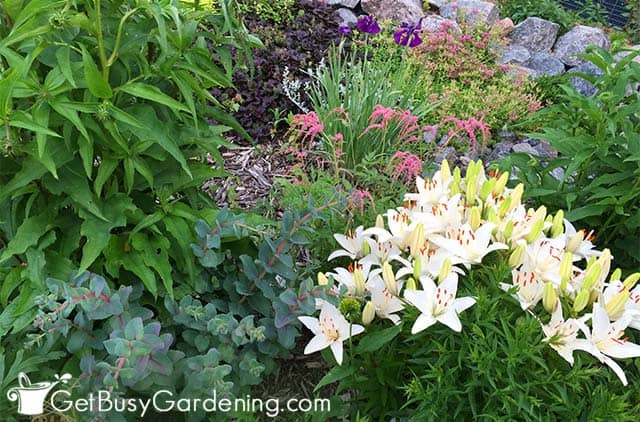
Stake Your Plants
Some perennials can get a little top-heavy when they’re covered in gorgeous blooms, and can flop to the ground under all that weight.
To keep them blooming longer, and your garden looking it’s best, stake any plants that need the extra support.
I find that wire tomato cages or grow through hoops work great for most of my plants. For larger ones, I use heavy-duty metal stakes for extra support.
Related Post: How To Support Peonies To Keep Them From Falling Over
Mixing several plants from this list into one area will ensure your perennial beds will be popping with color all year long, and ever-blooming through the entire growing season. Just remember, avoiding flower fixation will lead to amazing gardens.
Do you have any tips to add to this post about perennials made easy? Please share them in the comments section below.
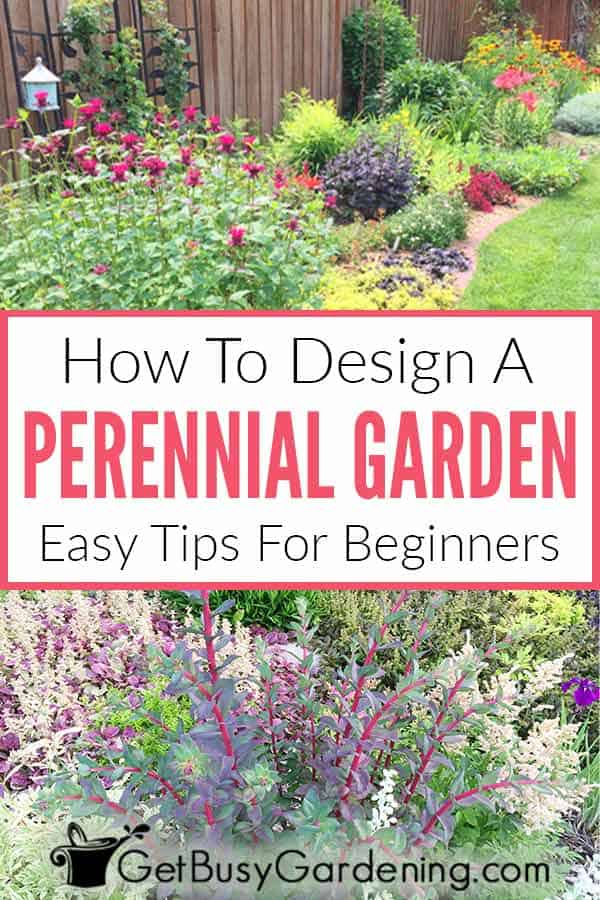

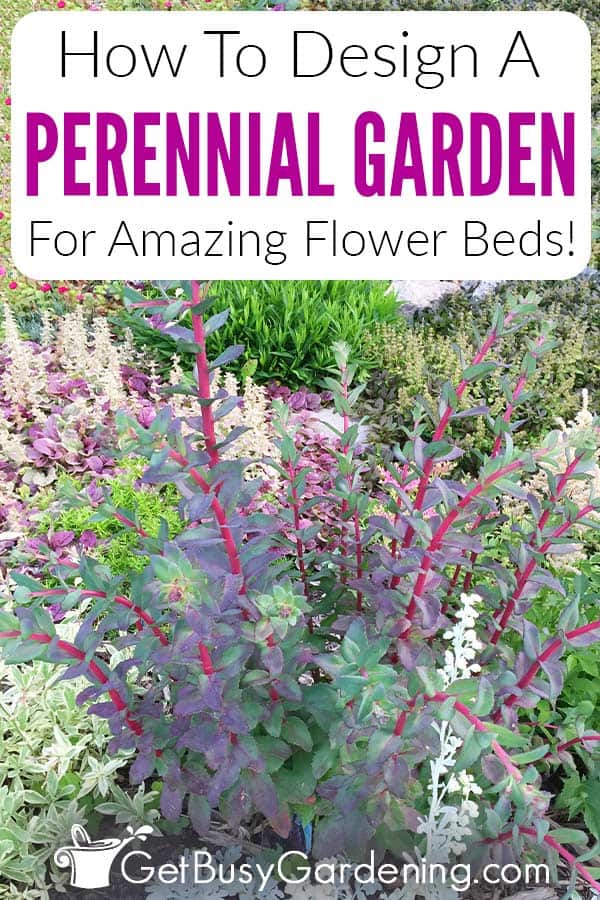
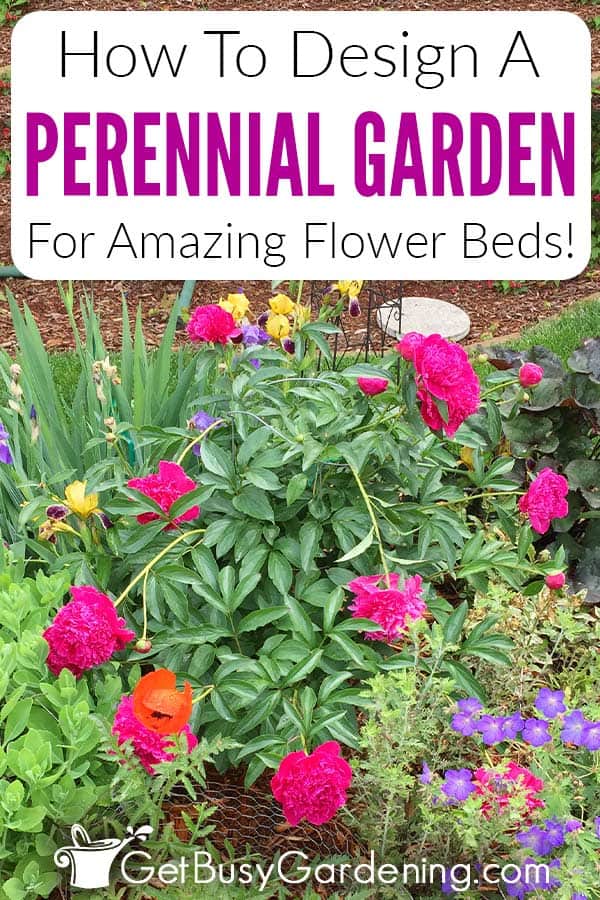
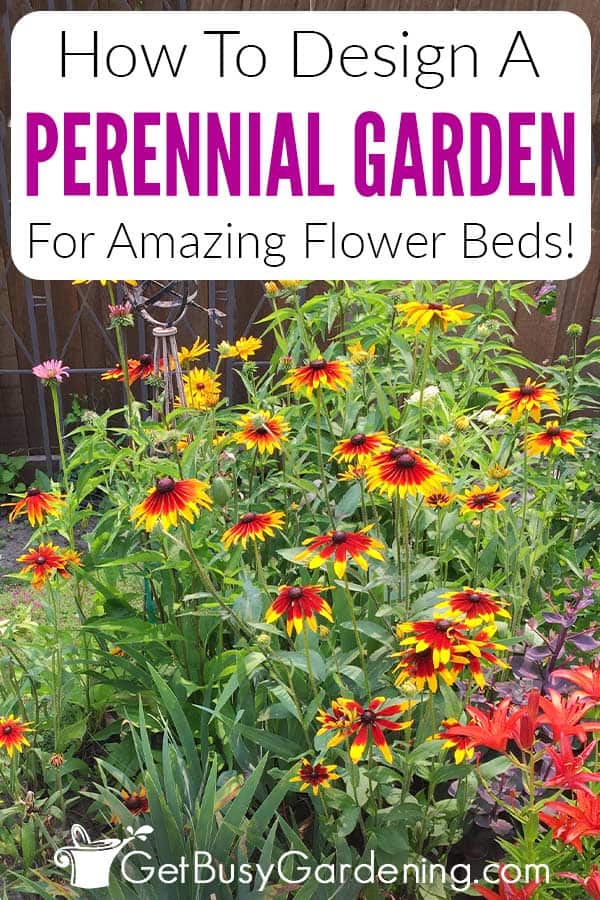
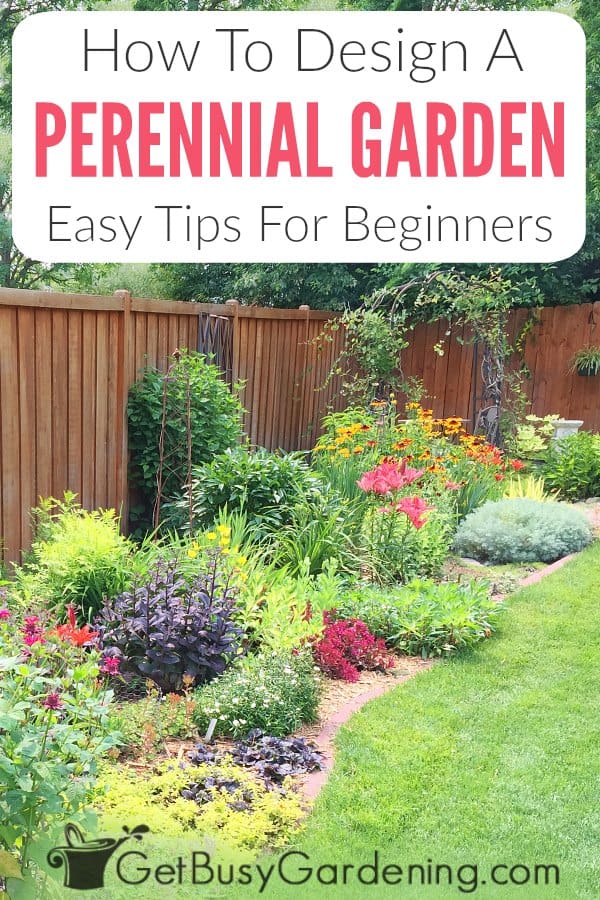
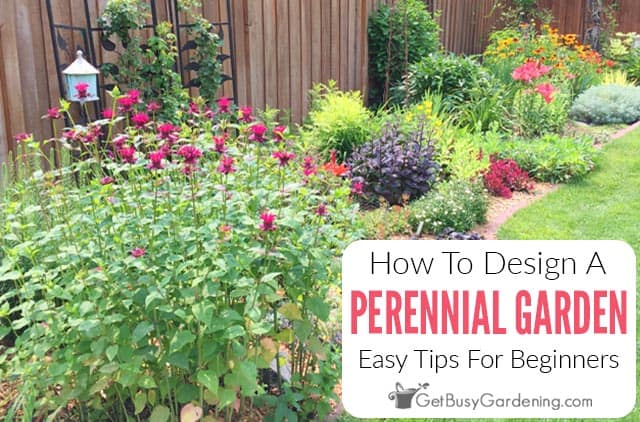


Ivory says
Lovely! I am slow growing my flower garden and hope it will look half as gorgeous as yours.
Amy Andrychowicz says
Thank you, and I’m sure you perennial garden will look amazing soon! 🙂 Mine have been in the works for 15 years!
Theresa Shearer says
In the ‘4 season perennial garden’ pictures there is a dark purple bush/plant. What is the name of that? I have been looking for a plant like this.
Thank you
Amy Andrychowicz says
I think you’re talking about the tall dark purple sedum. It’s also in the photo “Dramatic perennial foliage color” behind the orange lilies. That one is called “Black Jack”. It’s one of my favorites for adding amazing color to my gardens!! It’s flowering in the photo that you’re asking about, and not flowering in the others so it looks a bit different. 🙂
Theresa Shearer says
Hi Amy. Thanks for getting back to me. I do have a purple sedum however I was looking at the plant in front it and beside the plant with white flowers. The plant looks almost black. I have seen this before but do not know the name. Thanks again.
Theresa
Amy Andrychowicz says
Oops, sorry to ID the wrong plant, LOL! The short ground cover you’re asking about is called ajuga ‘Black Scallop’.
Theresa Shearer says
Thanks Amy! I will look for these plants.
Sue says
Your gardens are beautiful! Thanks for sharing the article and the pics!
Amy Andrychowicz says
Thank you! 🙂
Marilyn Winters says
I have too have been focusing on more perennials in my gardens. I get more by dividing them. Thank you for sharing your photos.
Amy Andrychowicz says
You’re welcome. Glad you enjoyed the post. 🙂 Dividing perennials is a great way to expand your perennial gardens, for sure.
Sue says
Great info, your gardens are gorgeous! Thanks for sharing all this information!
Amy Andrychowicz says
Thanks, and you’re welcome! 🙂
Ivory says
Your garden is breathtaking , I love, love,love it! Now when I go into a nursery I no longer look at blooming flowers to buy. Thank you for that wonderful money saving tip. I love buying flowers from Home Depot at the end of the year, because that’s when they have clearance racks at a steal.
Amy Andrychowicz says
Awe, thanks! You’re welcome, have fun bargain shopping for new perennial plants!
Becca says
Love this article! Just built a house in what used to be a cornfield and have no green thumb so I am very new to gardening and planning plants out and this has really helped me get started!! Thanks!
Amy Andrychowicz says
Great, glad to hear it! Have fun designing your new perennial flower garden!
DJ says
Great info in a nutshell!
Amy Andrychowicz says
Thanks! 🙂
Cherie says
I love your gardens. I would love to know what the names of all those flowers are and what zone you are in. Thank you so much for sharing your pictures and your tips.
Amy Andrychowicz says
I’m in Minneapolis, zone 4b
Anne Phernetton says
Love your gardens. We share the same philosophy with perennials. I’m in Red Wing, just an hour South of you. Will look for that red stemmed sedum. It’s gorgeous.
Amy Andrychowicz says
Awesome! Yes, it is gorgeous. I love sedums!
Ashley says
when you started speaking about the Foliage, the second picture cought my eye, I was hoping you could tell me the name please?
Amy Andrychowicz says
That one with the red stems is a sedum telephium ‘Red Cauli’
Julie Briggs says
Good advice! I think the longer you garden, the more you come to appreciate the “workhorses” of your flower garden beds – the plants that look great all season long, whether they are blooming or not.
Amy Andrychowicz says
Yes, totally!
Darlene says
I draw a picture/ draft of my garden and then place flowers of different seasons in different areas to make sure all seasons are disbursed throughout the garden. I keep a binder with the draft and pictures of the different seasons so I always know what is where and when it will return.
Amy Andrychowicz says
Wow, sounds like you are super organized! I’d love to see your binder. 🙂 Thanks for sharing your tips!
Mary says
These are great tips! I am saving this for the next time I go to the nursery! Your flower beds look gorgeous in all of the pictures!
Amy Andrychowicz says
Awesome! Thank you. 🙂
Kim says
We just moved into a new home (new to us) and the yard is a blank canvas. I am taking this summer to plan the garden and this post is going to help me so much! Great advice!!
Amy Andrychowicz says
Nice! That sounds like a ton of fun. Hope you’ll share pictures!
Andie says
I’m doing the same thing!! I have recently found some great ideas on how I want to develop the space and shapes in the yard, and I am do excited I found this post. I will work hard to not develop flower fixation. Thank you so much!
Amy Andrychowicz says
Wonderful, so happy you found this helpful. Flower fixation is so hard to resist, but you can do it!! LOL!
Vanessa D. says
I like to do a lot of perennials and then add pockets of annuals for color. Even in my containers though, I focus on the foliage and treat the flowers as happy little bonuses.
Amy Andrychowicz says
Awesome! I bet your perennial gardens are gorgeous year round!
Tom @ Raise Your Garden says
Well, I spend the majority of my time killing my wife’s perennials in the act of “weeding” then she gets all mad at me and tells me how expensive they are. And her sister doesn’t share too many of her plants so they we’r’e up a crick. But we love perennials for exactly what you said ~ sick of replacing annuals each year. Although we do both.
Amy Andrychowicz says
Haha, oh no!! This is why my husband only weeds the garden when I’m there showing him exactly what to pull. LOL! I know what you mean, but I grow annuals too – it’s hard to beat their constant color in the gardens. 🙂